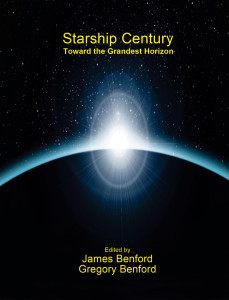 I hope you read this entire review because it can be misleading and taken out of context if paraphrased. Especially when I begin by noting the one reason Starship Century, edited by James Benford and Gregory Benford, was not a pleasure to read. With every page, it becomes more and more obvious that this book NEEDS to be read. By this, I mean it is a sad state of affairs when we need to be discussing the importance of space exploration. Yet here we are, pleading to the masses for what should be the obvious. Why go to the stars? – Because to survive as a species, it is our imperative to expand territorially as well as intellectually and socially.
I hope you read this entire review because it can be misleading and taken out of context if paraphrased. Especially when I begin by noting the one reason Starship Century, edited by James Benford and Gregory Benford, was not a pleasure to read. With every page, it becomes more and more obvious that this book NEEDS to be read. By this, I mean it is a sad state of affairs when we need to be discussing the importance of space exploration. Yet here we are, pleading to the masses for what should be the obvious. Why go to the stars? – Because to survive as a species, it is our imperative to expand territorially as well as intellectually and socially.
Before becoming a book, Starship Century was a symposium organized to address the prospect of space travel. What the coordinators (the Center for Human Imagination) got, was an impressive cast of participants from both fields of science and science fiction. The book Starship Century is a compilation of musings and anecdotes from the uniquely qualified minds who contributed to the symposium.
This collection is divided into four distinct stages focused on a future with space travel. Each stage includes a cohesive blend of theoretical observations filled with scientific facts along with entertaining yet emotional prose showing the reader “what if” these ideas evolve into reality.
The first stage is titled “The big perspective,” and examines the social view of space travel as a necessity. The reality of the enormous distances between stars, the technological challenges we face to make it happen, and the political struggle between the status quo and the dreamers is perhaps the most imperative obstacle to overcome. For if this stage does not clear, all others become mute.
As Stephen Hawking states in the book, “Our only chance of long-term survival is not to remain lurking on planet Earth, but to spread out into space.” Author Allen Steele takes the reader back to his successful Coyote series (well, actually he takes us into the distant future of the series) where man has traversed the universe and found home in a remote solar system. The story Cathedrals looks at the significance of ideas, successful or not, and how the mere initiative can be built upon to further man’s advancements.
The second stage is “Pathways toward Starships,” which is a blueprint on the dedication it will take to reach the stars. Neal Stephenson and Gregory Benford combine two stories spanning generations. The commitment of space travel becomes more of an allegiance to a goal far into the future. Those in the present are driven on pure faith that their work will be completed long after they are gone.
The third stage is “Building Starships.” This is perhaps the most detailed portion of the book as historical facts, technological breakthroughs, and theoretical options for space travel are examined. As a fan of hard science fiction, this section will be the one I return to the most. It is by no means dry reading, but after the reader gets through this section, he or she may need the catch there breath. There are obviously a lot of options (and obstacles) in front of us. As a society, we need to accept them and continue to move forward.
The fourth and final stage is “The Starship Era.” Here, we learn about our destination. Space truly is the final frontier. We just need to decide where to go from here and how quick we want to get there. This isn’t anything new. Joe Haldeman’s Hugo award winning short Tricentennial is included in this stage of the book for a reason. Almost forty years later, we still see the rift between those who want to discover what is out there and those who are afraid to give it a try. Even if our dreams of exploration come to fruition, there will always be an element of hesitation and skepticism.
 On the intellectual side, the science representatives in Starship Century are: James Benford, John Cramer, Ian Crawford, Adam Crowl, Paul Davies, Freeman Dyson, Stephen Hawking, Geoffrey A. Landis, Martin Rees, Peter Schwartz and Robert Zubrin. On the literary side, the science fiction contributions came from Stephen Baxter, Gregory Benford, David Brin, Joe Haldeman, Nancy Kress, Richard Lovett, Allen Steele and Neal Stephenson. Through both fact and fiction, the theme remained the same. The advancement of civilization has always relied on exploration, and if we want to avoid taking a step back as a society, we must move forward. Moving forward from a terrestrial standpoint does not mean “reaching for the stars” metaphorically, but actually reaching the stars – physically.
On the intellectual side, the science representatives in Starship Century are: James Benford, John Cramer, Ian Crawford, Adam Crowl, Paul Davies, Freeman Dyson, Stephen Hawking, Geoffrey A. Landis, Martin Rees, Peter Schwartz and Robert Zubrin. On the literary side, the science fiction contributions came from Stephen Baxter, Gregory Benford, David Brin, Joe Haldeman, Nancy Kress, Richard Lovett, Allen Steele and Neal Stephenson. Through both fact and fiction, the theme remained the same. The advancement of civilization has always relied on exploration, and if we want to avoid taking a step back as a society, we must move forward. Moving forward from a terrestrial standpoint does not mean “reaching for the stars” metaphorically, but actually reaching the stars – physically.
I stated at the beginning how unfortunate it is that this book needs to be read. The people who need to read Starship Century are the people who are comfortable with the status quo and do not care about a future they will never see. But the dreamers are the people who imagine a future in the stars. These are the people who WILL read Starship Century because it validates their core belief and gives them hope. Why go to the stars? – Because if we don’t, who will?











1 Comment